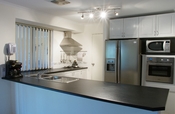Because of our constant contact with different rooms, it is not unexpected that we come across references to this interaction in novels from all around the world, including "Like Water for Chocolate", from South America, and "Paradise of the Blind", from Vietnam. Settings in novels such as these are used many times by the author as metaphors and a parallel to the tone and mood of the passage. This is especially constructive because of our ability to relate to the settings that have been described, even if we are unable to associate with the action itself. Since the setting encompasses all of the characters, the description and the actions undertaken in that setting can be largely understood through an analysis of the surroundings. More profoundly, as well as describing the atmosphere of the novel, Laura Esquivel uses the kitchen, and Duong Thu Huong uses the roof, as stable motifs to relate the characters back to during major stages of the plot.
As a result, by considering the purpose of the kitchen and the roof, we can better understand the feelings of the characters, and the general atmosphere of the scene. This comparative paper will evaluate the ways in which the kitchen and roof are manipulated by the authors for the above purposes in both works.
From the beginning of "Like Water for Chocolate" Esquivel portrays the importance of the kitchen in Tita's demanding life. The kitchen is revealed as being Tita's domain, where she alone is constantly working to obey the suffocating demands of her mother, Mama Elena. "Everything on the kitchen side of the door, on through the door leading to the patio and the kitchen... was Tita's realm." In addition, Laura Esquivel uses the kitchen as a metaphor for Tita's refuge, both from the constant shower...


